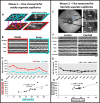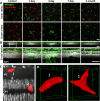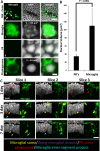Photoreceptor loss does not recruit neutrophils despite strong microglial activation
- PMID: 40694413
- PMCID: PMC12283074
- DOI: 10.7554/eLife.98662
Photoreceptor loss does not recruit neutrophils despite strong microglial activation
Abstract
In response to central nervous system (CNS) injury, tissue-resident immune cells such as microglia and circulating systemic neutrophils are often first responders. The degree to which these cells interact in response to CNS damage is poorly understood, and even less so, in the neural retina, which poses a challenge for high-resolution imaging in vivo. In this study, we deploy fluorescence adaptive optics scanning light ophthalmoscopy (AOSLO) to study microglia and neutrophils in mice. We simultaneously track immune cell dynamics using label-free phase-contrast AOSLO at micron-level resolution. Retinal lesions were induced with 488 nm light focused onto photoreceptor (PR) outer segments. These lesions focally ablated PRs, with minimal collateral damage to cells above and below the plane of focus. We used in vivo AOSLO, and optical coherence tomography (OCT) imaging to reveal the natural history of the microglial and neutrophil response from minutes to months after injury. While microglia showed dynamic and progressive immune response with cells migrating into the injury locus within 1 day after injury, neutrophils were not recruited despite close proximity to vessels carrying neutrophils only microns away. Post-mortem confocal microscopy confirmed in vivo findings. This work illustrates that microglial activation does not recruit neutrophils in response to acute, focal loss of PRs, a condition encountered in many retinal diseases.
Keywords: adaptive optics; adaptive optics scanning laser ophthalmoscope; age-related macular degeneration; immunology; inflammation; leukocytes; mouse; neuroscience; scanning laser ophthalmoscopy; uveitis.
© 2024, Power et al.
Conflict of interest statement
DP, JS financial support from Genentech, Inc, JE is affiliated with Genentech, Inc
Figures

















Update of
-
Photoreceptor loss does not recruit neutrophils despite strong microglial activation.bioRxiv [Preprint]. 2025 May 29:2024.05.25.595864. doi: 10.1101/2024.05.25.595864. bioRxiv. 2025. Update in: Elife. 2025 Jul 22;13:RP98662. doi: 10.7554/eLife.98662. PMID: 38854151 Free PMC article. Updated. Preprint.
Similar articles
-
Photoreceptor loss does not recruit neutrophils despite strong microglial activation.bioRxiv [Preprint]. 2025 May 29:2024.05.25.595864. doi: 10.1101/2024.05.25.595864. bioRxiv. 2025. Update in: Elife. 2025 Jul 22;13:RP98662. doi: 10.7554/eLife.98662. PMID: 38854151 Free PMC article. Updated. Preprint.
-
Optical coherence tomography (OCT) for detection of macular oedema in patients with diabetic retinopathy.Cochrane Database Syst Rev. 2015 Jan 7;1(1):CD008081. doi: 10.1002/14651858.CD008081.pub3. Cochrane Database Syst Rev. 2015. PMID: 25564068 Free PMC article.
-
Cone Density Changes After Repeated Low-Level Red Light Treatment in Children With Myopia.JAMA Ophthalmol. 2025 Jun 1;143(6):480-488. doi: 10.1001/jamaophthalmol.2025.0835. JAMA Ophthalmol. 2025. PMID: 40272813 Free PMC article.
-
Optic nerve head and fibre layer imaging for diagnosing glaucoma.Cochrane Database Syst Rev. 2015 Nov 30;2015(11):CD008803. doi: 10.1002/14651858.CD008803.pub2. Cochrane Database Syst Rev. 2015. PMID: 26618332 Free PMC article.
-
Optical coherence tomography (OCT) for detection of macular oedema in patients with diabetic retinopathy.Cochrane Database Syst Rev. 2011 Jul 6;(7):CD008081. doi: 10.1002/14651858.CD008081.pub2. Cochrane Database Syst Rev. 2011. Update in: Cochrane Database Syst Rev. 2015 Jan 07;1:CD008081. doi: 10.1002/14651858.CD008081.pub3. PMID: 21735421 Updated.
Cited by
-
Longitudinal High-Resolution Imaging of Retinal Sequelae of a Choroidal Nevus.Diagnostics (Basel). 2025 Jul 29;15(15):1904. doi: 10.3390/diagnostics15151904. Diagnostics (Basel). 2025. PMID: 40804868 Free PMC article.
References
-
- Allen C, Thornton P, Denes A, McColl BW, Pierozynski A, Monestier M, Pinteaux E, Rothwell NJ, Allan SM. Neutrophil cerebrovascular transmigration triggers rapid neurotoxicity through release of proteases associated with decondensed DNA. Journal of Immunology. 2012;189:381–392. doi: 10.4049/jimmunol.1200409. - DOI - PMC - PubMed
-
- American Academy of Ophthalmology Current ROP Therapies: How Laser and Anti-VEGF Compare. 2014. [February 1, 2014]. https://www.aao.org/eyenet/article/current-rop-therapies-how-laser-antiv...
-
- Boyce M, Xin Y, Chowdhury O, Shang P, Liu H, Koontz V, Strizhakova A, Nemani M, Hose S, Zigler JS, Jr, Campbell M, Sinha D, Handa JT, Kaarniranta K, Qian J, Ghosh S. Microglia-neutrophil interactions drive dry AMD-like pathology in a mouse model. Cells. 2022;11:3535. doi: 10.3390/cells11223535. - DOI - PMC - PubMed
MeSH terms
Associated data
Grants and funding
LinkOut - more resources
Full Text Sources
Research Materials

